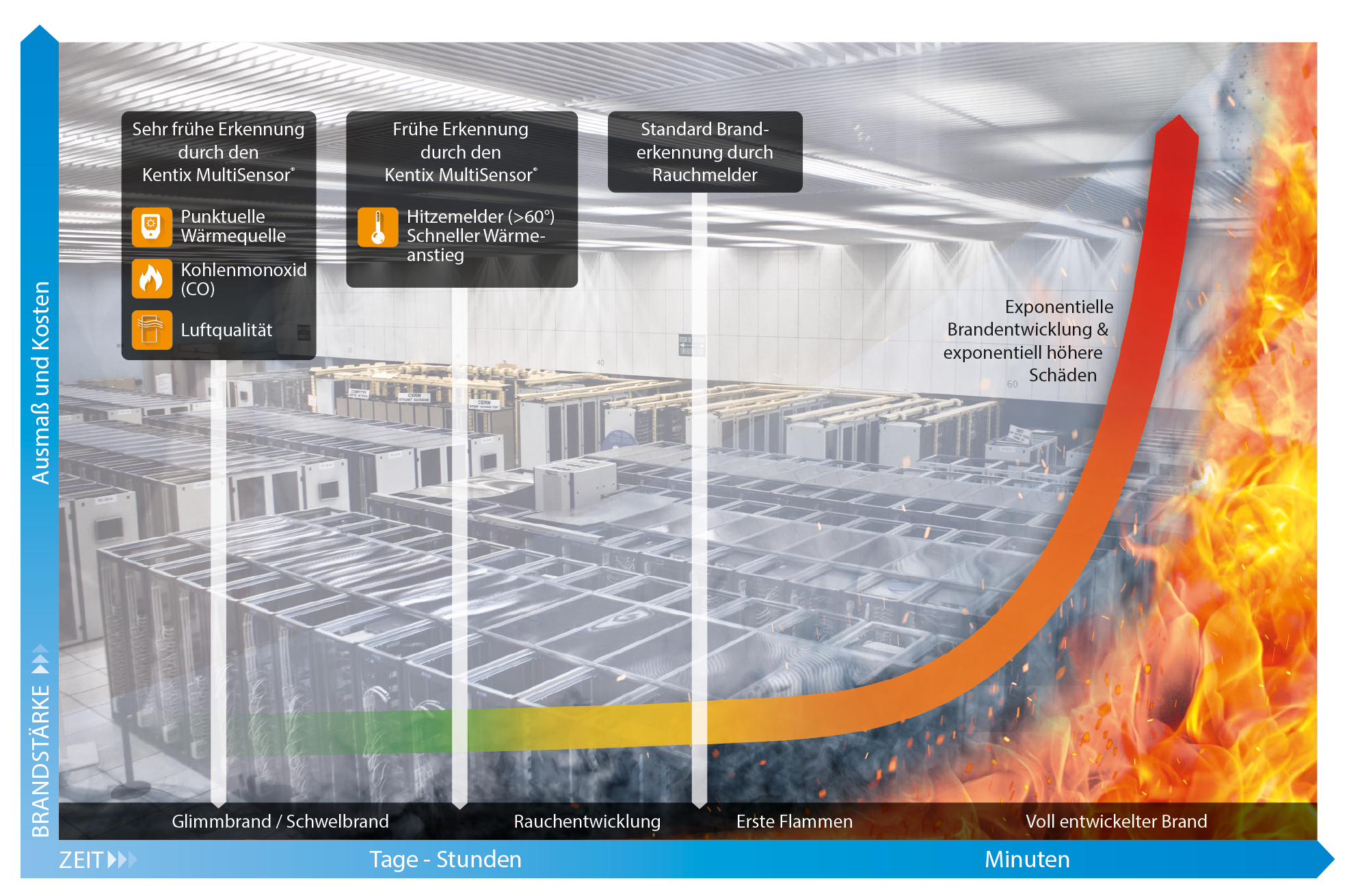Is it possible to detect a fire days before it breaks out?
Fire is one of the greatest threats to companies, data centers and public institutions. Not only can it cause considerable damage to property, it can also endanger human life. Timely detection of fires is therefore of the utmost importance in order to enable quick reactions and effective evacuations – this also involves the safety of employees. Like fire protection, this aspect of security technology for companies should not be neglected.
Definition and importance of early fire detection
The early detection of fires refers to the timely detection and early alerting of fires in order to minimize damage to people, property and the environment. It is a system or combination of technologies developed to identify potential fire outbreaks at an early stage, before they can develop into larger and more dangerous fires. Fire detection involves monitoring smoke, temperature, gases and other indicators that may point to the presence of a fire. By using modern sensor technologies, thermal imaging cameras and advanced algorithms, early fire detection systems can enable a rapid response by triggering automatic alarms and simultaneously forwarding relevant information to emergency services or people on site.
Early fire detection is a crucial aspect of fire protection, as it enables a rapid response to a fire. Conventional smoke detectors and fire alarms are generally limited to the protection of residential buildings and smaller rooms. In larger buildings and complex facilities, however, more advanced early fire detection systems are required to provide early warning of potential hazards. Fires in technical systems, for example, are often (>50%) caused by electrical faults and can have a variety of causes and lead to short circuits and/or outbreaks of fire. These include, for example:
- Insulation fault
- Overcurrents
- improper maintenance/installation of electrical systems
- Overheated cables
- defective devices
An automatic early fire detection system can detect such electrical faults and sound the alarm at an early stage to minimize the risk of fire (fire prevention).
Functions of an automatic early fire detection system
An automatic early fire detection system consists of various components that work together to detect a fire and trigger alarms. Here are some important functions of such a system:
Smoke and heat detectors: These sensors continuously monitor the room for signs of smoke or heat that could indicate a fire.
Fire alarm control panel: This control panel receives the signals from the sensors and evaluates them. If it detects a possible fire, it triggers an alarm and informs security personnel or the fire department.
Alarm system: The automatic early fire detection system can trigger various types of alarms, such as sirens, flashing lights or voice announcements, to warn people in the building and initiate an evacuation.
With its innovative features, the Kentix MultiSensor offers brilliant possibilities for early fire detection. The combination of sight (camera / thermal imaging camera) and smell (smoke sensor), just like a dog, gives the sensor enormous sensory power to protect your system-critical infrastructure.
Advantages of automatic early fire detection
The use of an automatic early fire detection system offers a number of advantages:
Early detection: The sensors can detect fires at a very early stage, even before smoke or flames are visible. This leaves more time for evacuations and for the fire department to intervene. Fires can often even be detected by the Kentix MultiSensor before they actually break out.
Reliability: Automatic early fire detection systems work around the clock and are not dependent on human vigilance. This ensures that fires are detected even when no one is in the room.
Minimizing damage: By detecting fires at an early stage, quick action can be taken to limit the damage and prevent the fire from spreading.
Integration with other systems: Modern early fire detection systems can be integrated with other security systems such as access control and video cameras to enable comprehensive monitoring and response to events.
Special features of early fire detection when storing batteries
Batteries are widely used in many devices and applications, from cell phones and laptops to electric vehicles and energy storage systems. Although batteries are generally safe, there is still a small risk of fire, especially if they are stored improperly or damaged.
Fire protection and early fire detection, ideally before the fire breaks out, are therefore even more important in the storage of batteries than in other industrial buildings due to the hazardous substances involved. Temperature and humidity sensors can also be used here to ensure that the storage conditions are safe. Excessive heat or moisture can affect the stability of the batteries and increase the risk of fire. It is therefore important to continuously monitor these parameters and take appropriate measures in the event of deviations.
The following special features apply to battery storage:
Fire hazard due to thermal reactions: Rechargeable batteries contain chemical compounds that can cause increased heat generation if stored improperly or damaged. These thermal reactions can lead to a fire. It is therefore important to monitor the temperature in the storage areas and to use early warning systems that trigger an alarm if the temperature rises.
Gas development: Some batteries can release gases when overcharged or damaged. These gases can be flammable and contribute to the development of a fire. It is therefore advisable to install gas detectors in the storage areas that can detect an increased concentration of flammable gases and trigger an alarm.
Smoke development: In the event of a fire, batteries can develop smoke, which should be detected at an early stage. The use of smoke detectors in storage areas is therefore of great importance to ensure a rapid response and prevent the spread of fire.
In addition, care should be taken to ensure adequate spatial separation when storing batteries. Good storage practice dictates that batteries should not be stored near flammable materials or other potentially hazardous substances. This reduces the risk of fires caused by contamination or external influences.
Finally, the training of personnel working in the storage of batteries should not be forgotten. Employees should be informed of the potential hazards associated with storing batteries and trained in appropriate measures for early fire detection and suppression. This enables them to react quickly and correctly in an emergency to minimize damage.


